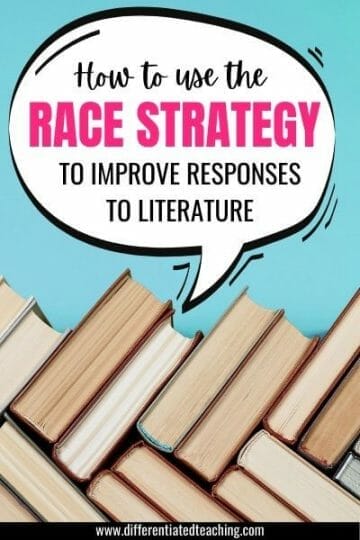Spring Novels for Teachers & Homeschoolers
When you think of spring, you might think of rainy weather and new growth. However, it is also a time where you can begin to help your students apply their reading comprehension skills to great books. Although many schools focus on test prep, bringing engaging literature into your classroom can be a great way to review those important lessons you’ve spent all winter teaching.
Spring-themed novels and chapter books are a great opportunity to do just that. Plus, they offer so many great cross-curricular connections that can take students beyond the four walls of your classroom.
Because I received so many great comments about my winter novel collection, I wanted to take a moment to share some of my favorite novels to read with learners in spring. Whether you’re an overwhelmed teacher trying to figure out what your next steps are for reading instruction or a homeschool parent looking for a great read for your own kiddo, this list will help you find your next great literary adventure.
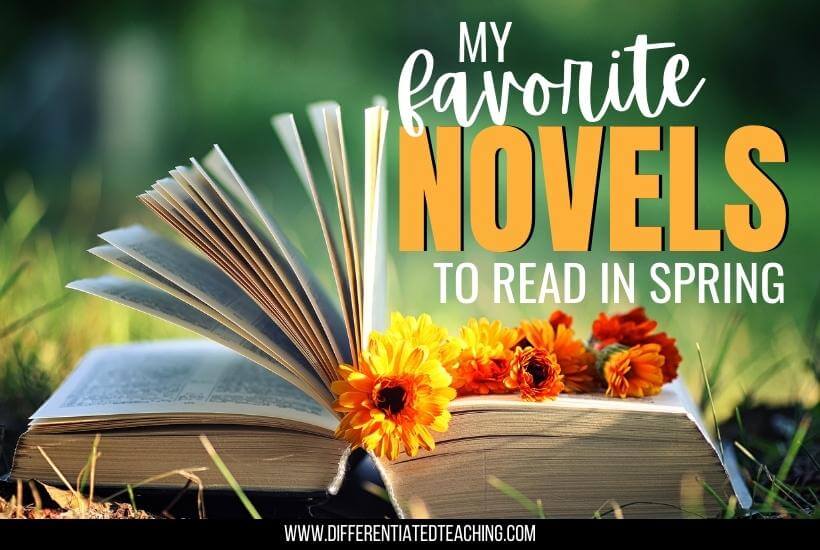
20 Amazing Novels to Read with Kids in Spring
Spring is a time when many classrooms begin to have some additional flexibility in their lesson planning. Testing is coming to a close, and summer break is approaching. This flexibility means that many learners getting their first opportunity to dive into a novel study.
This list contains my favorite books to use for a spring novel study. You’ll find that I’ve included some important information that I hope will help you find the perfect text for your students. Here’s what you’ll find:
- A brief synopsis for each book
- General reading level information
- Ideas for cross-curricular connections
- A link to help you find where to get the print or audio version of the book
- Links to the ready-to-use novel study units (when available)
Some of the links included in this post are affiliate links, which means when you click and buy through the link provided you’re helping me cover the costs to keep this site up and running.
My hope is that having these resources at your fingertips will help you save time when preparing your lessons this spring.
1. Charlotte’s Web
It should come as no surprise that E.B. White’s classic makes the list of the best spring novels for readers.
The novel follows Wilbur’s first year of life as he transitions from the runt of the litter to a blue ribbon pig. From the tender moments of “motherly” love he receives from Fern to his budding friendship with a bright and talented spider, this story is a winner from beginning to end.
As an added bonus, this story has been remade into a movie several times, which makes it great for doing comparisons of a story across different forms of media. While the most recent version created in 2006 includes big names like Julia Roberts and Dakota Fanning, my personal favorite is the animated version from the 1970s because it’s got such catchy music.
Regardless of whether you offer the opportunity to watch the movie after reading, you’re sure to love this classic tale of a spring pig who overcomes the odds stacked against him.
Cross-curricular connections: Science – Lifecycles; Social Studies – urban vs. rural
Ideal for: 3rd-5th graders
Teach with Charlotte’s Web
- Buy the book: Charlotte’s Web
- Get the audiobook: Charlotte’s Web on YouTube
- Lesson Materials: Charlotte’s Web Novel Unit
2. Track: Ghost
Ghost, the first book in Jason Reynolds’ Track series, is a great option for a spring novel when many students are beginning their track season.
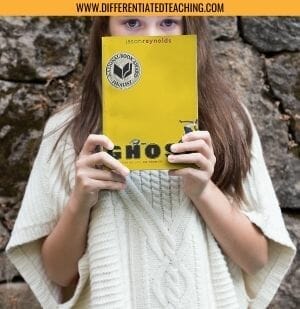
This National Book Award Finalist follows the story of a teen named Castle, who has had a rough start in life. With a dream of playing basketball with the big boys, Castle reluctantly agrees to join the city track team after Coach promises that he’ll be dunking in no time.
As we follow his efforts toward his first track meet, Castle makes more than his fair share of mistakes, but it’s clear to readers that inside he’s a good person who is trying to make the best of a tough situation. Along the way, his coach becomes a mentor who helps him begin to discover the path to who he truly wants to be.
On the day of the first meet, he’s feeling the pressure…but can he win?
Cross-curricular connections: Social Emotional Learning – grit, growth mindset
Ideal for: 5th-7th graders
Teach with Ghost
- Buy the book: Ghost
- Get the audiobook: Ghost FREE on FreeTime Unlimited
- Lesson Materials: Ghost Novel Unit
3. The Secret Garden
The Secret Garden, by Frances Hodgeson Burnett, is a classic story that has been enjoyed by children for over 100 years, and it makes the perfect spring novel. It is the story of Mary Lennox, an orphan of the cholera epidemic. When she is sent to live with her uncle in England, she finds herself lonely and isolated in the countryside.
That is until one day when she happens upon a door to a secret garden. As the story goes on, the reader witnesses a remarkable transformation. Mary, her bossy cousin Colin, and a friend they make along the way secretly work together to make the long-forgotten garden bloom.
This story is a great opportunity to talk about character change and bring in discussions about the historical impact of epidemics of the past.
Cross-curricular connections: Social Emotional Learning, Science – plants, Health – illnesses/epidemics
Ideal for: 5th-7th graders
Teach with The Secret Garden
- Buy the book: The Secret Garden
- Get the audiobook: The Secret Garden FREE with Scribd trial
- Lesson Materials: The Secret Garden Novel Unit
4. The Trumpet of the Swan
The Trumpet of the Swan is another E.B. White classic novel. It’s the story of Louis, a Trumpeter Swan. However, unlike most Trumpeter Swan’s, Louis has no voice. Despite this challenge, he is determined to communicate.
When he leaves home, he meets Sam Beaver, a human who teaches him to read and write. Returning home, Louis realizes that this isn’t enough because his love cannot read his love notes, and he is still unable to communicate with her. Determined to resolve the issue, Louis embarks on an adventure that takes him far from home, but will it be enough?
With rich language and a timeless tale of love, courage, and finding your own way, E.B. White weaves a masterful tale that will surely capture the reader’s imagination. This a great example of fantasy for your 4th-grade readers.
Cross-curricular connections: Social Emotional Learning – grit, growth mindset
Ideal for: 4th-6th graders
Teach with The Trumpet of the Swan
- Buy the book: The Trumpet of the Swan
- Get the audiobook: The Trumpet of the Swan on Chirp Audiobooks
- Lesson Materials: The Trumpet of the Swan Novel Unit
5. Because of Winn-Dixie
Because of Winn-Dixie is a great story of love and friendship written by award-winning author Kate DiCamillo. The story focuses on the relationship between a lonely young girl and a stray dog she meets one day at her local grocery store. Despite her father’s objections, the girl is determined to keep the dog, who she names Winn-Dixie.
The pair have many adventures, and Winn-Dixie helps the girl (named Opal) begin to make friends in her new town. After nearly losing Winn-Dixie in a thunderstorm, Opal begins to rekindle her tepid relationship with her father and begins to realize the value of the love and friendships she has made.
A beautiful story of the power of pets, Because of Winn-Dixie has so many deep and meaningful layers. As a teacher, you’ll love the rich vocabulary and discussions the book fosters among your learners. Several years ago this book was also made into a movie, which offers even more opportunities to touch on core standards.
Cross-curricular connections: Social Emotional Learning – grit, growth mindset
Ideal for: 3rd-5th graders
Teach with Because of Winn-Dixie
- Buy the book: Because of Winn-Dixie
- Get the audiobook: Because of Winn-Dixie on Audible
- Lesson Materials: Because of Winn-Dixie Novel Unit
6. My Father’s Dragon
My Father’s Dragon is a great fairy tale story designed to enthrall your readers. The story of Elmer Elevator and his adventures when he runs away to rescue a baby dragon, this story is an imaginative masterpiece.
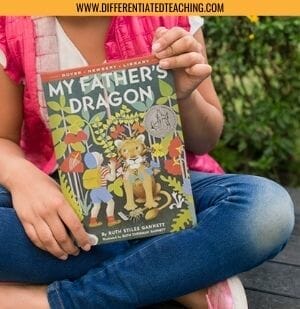
With beautiful illustrations, learners will follow Elmer’s path as he faces dangerous creatures and must figure out how to outsmart each one with only the supplies he has.
With a smart and creative main character, this book can be a great lead-in to some good STEM learning opportunities as part of your spring novel study.
Cross-curricular connections: Social Emotional Learning – grit; Science – habitats; STEM
Ideal for: 2nd-3rd graders
Teach with My Father’s Dragon
- Buy the book: My Father’s Dragon
- Get the audiobook: My Father’s Dragon on Audible
- Lesson Materials: My Father’s Dragon Novel Unit
7. Pippi Longstocking
While this isn’t directly a spring novel, it is a favorite for students. If you’ve got a group with a great sense of humor, this is the perfect novel to capture their attention and spark some silly conversation. This story about a young girl with some strange habits is sure to get your students giggling.
The story centers around the title character, Pippi, who has come to live in her family’s home while her dad continues to sail the sea. Of course, Pippi isn’t totally alone! She has her monkey and horse to keep her company, and it isn’t long before she’s made friends with the siblings next door.
As the story continues, readers follow Pippi’s nonsensical adventures as she traverses an unfamiliar world in her own unique way. Your students will love Pippi’s kind heart and slightly unusual way of handling life’s challenges, and if you have time, this is another GREAT opportunity to compare the story in two formats because the movie (affiliate link) is fantastic.
Cross-curricular connections: Wants vs. Needs; Math
Ideal for: 3rd-5th graders
Teach with Pippi Longstocking
- Buy the book: Pippi Longstocking
- Get the audiobook: Pippi Longstocking on Audible
- Lesson Materials: Pippi Longstocking Novel Unit
8. Spring According to Humphrey
The According to Humphrey series is another favorite amongst students, and this book is perfect makes a great spring book club or novel unit. This is the 12th book in the series, but it might just encourage your readers to go back and enjoy Humphrey’s story from book 1.
Told through the perspective of Humphrey, the class hamster, the story follows a classroom of students through their many explorations into the wonders of springtime. With the signs of spring everywhere, Humphrey’s most important lesson is that families come in many different forms.
Cross-curricular connections: Social Studies – family & communities
Ideal for: 3rd-5th graders
Teach with Pippi Longstocking
- Buy the book: Spring According to Humphrey
- Get the audiobook: Spring According to Humphrey on the Google Play Store
- Lesson Materials: Spring According to Humphrey Novel Unit (coming soon)
9. Bridge to Terabithia
This story is a classic tale of friendship and the power of imagination. The story follows Jess Aarons, a boy determined to be the fastest boy in the 5th grade. Determined to find his moment in the sun, Jess struggles wtih the insecurities that many students will be all too familar with at this age.
However, Jess’ dreams are dashed when the new girl next door, Leslie, arrives and beats everyone in the race at recess. While you’d imagine this might be a barrier to any sort of relationship between the two, they eventually become fast friends. They create a fantasyland on the other side of a creek in the woods that they name Terabithia. This becomes their escape from the rest of the world.
Through Leslie’s friendship, Jess embraces his imagination and creativity. Together they are able to weather the challenges of early adolescence and the struggle to find one’s place in the world. However, when tragedy strikes, Jess must try to cope with his new reality and forge the path ahead.
Cross-curricular connections: Writing – Imaginative Stories
Ideal for: 3rd-5th graders
Teach with Bridge to Terabithia
- Buy the book: Bridge to Terabithia
- Get the audiobook: Bridge to Terabithia on Audible
- Lesson Materials: Bridge to Terabithia Novel Unit
10. Little House on the Prairie
The third book in the nine book The Little House series, this story focuses on the Ingalls family during their time on the Kansas prairie. An autobiographical story that takes the reader back to the 1800s, this story offers students a chance to immerse themselves into the westward expansion occuring at the time.
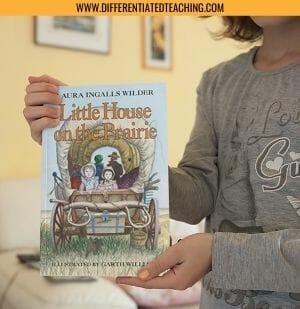
Facing the real dangers of illness and the perceived dangers of the nearby native peoples, Laura and her family work to make a life for themselves. Despite her mother’s fears of an attack, Laura’s curiosity gets the best of her and she spends a great deal of time observing the people who pass by.
When Ma’s fears of an attack appear to be a reality, it turns out their native neighbors will actually be their saving grace. An Osage chief who has become friends with Pa helps to avert the crisis. However, that doesn’t stop change from happening. After being informed they had no legal right to their home, the Ingalls must decide whether to stay and fight or find a new place to call their own.
Cross-curricular connections: Social Studies – past & present; pioneer life
Ideal for: 3rd-5th graders
Teach with Little House on the Prairie
- Buy the book: Little House on the Prairie
- Get the audiobook: Little House on the Prairie FREE on Freetime Unlimited
- Lesson Materials: Little House on the Prairie Novel Unit
11. The Hero Two Doors Down
Springtime is synonymous with baseball season for many students, and this story is a great opportunity to capture your readers with the story of a boy who discovers that hero, Jackie Robinson, has moved into his neighborhood. Based on a true story, and written by Robinson’s daughter Sharon, this story touches on so many important topics – including social injustice and discrimination.

As you can imagine, Stephen (the main character) is over the moon when he discovers his new neighbor is none other than Robinson himself. However, he also knows that many of his neighbors aren’t as enthusiastic about having an African American move into their all-Jewish neighborhood.
Determined to meet Robinson, Stephen actually becomes friends with the entire Robinson family and learns a great deal about overcoming adversity and cultural awareness along the way.
With great themes, real photos of the pair, and a diverse cast of characters, your students will love this story and so will you.
Cross-curricular connections: Social Studies – desegregation, diversity awareness
Ideal for: 3rd-5th graders
Teach with The Hero Two Doors Down
- Buy the book: The Hero Two Doors Down
- Get the audiobook: The Hero Two Doors Down on Audible
- Lesson Materials: The Hero Two Doors Down Novel Study
12. Love that Dog
April is Poetry Month, but it can be hard to find great books that incorporate poetry into a full story. That’s just one reason I really love this book by Sharon Creech.
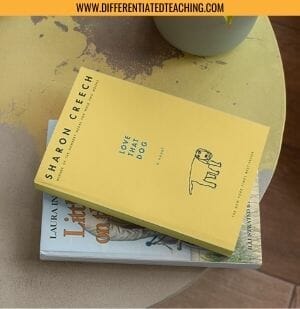
In this story, the main character, Jack, begins to find his voice as he works through the grief of losing his beloved pet dog. Like many students, Jack hates poetry and thinks it’s too girly for him. However, his teacher doesn’t give up on him, and the more he writes the easier it becomes. In the end Jack discovers he has lots to say and is eager to share.
If you’re looking for a great spring novel to introduce the flexibility of poetry, Love That Dog is such a good option.
Cross-curricular connections: Writing – Poetry; Social-Emotional Learning – grief
Ideal for: 3rd-5th graders
Teach with Love that Dog
- Buy the book: Love that Dog
- Get the audiobook: Love that Dog on Audible
- Lesson Materials: Love that Dog Novel Study
13. Elly: My True Story of the Holocaust
April marks Yom Hashoah, also known as Holocaust Remembrance. This novel offers an opportunity to help your students develop a better understanding of what that time period looked like for kids their age.
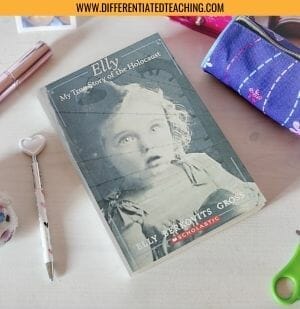
Written by a survivor, this story includes both the details of Elly’s experience in concentration camps and heartfelt poetry that captures the raw emotion of those difficult periods.
This text envelopes students into the story of one girl’s path to freedom and the dangerous path to get there. A great way to combine history and social studies with reading comprehension, a study of the Holocaust is a great way to engage students in a discussion about diversity and freedom.
Cross-curricular connections: History – WWII, the Holocaust
Ideal for: 6th-8th graders
Teach with Elly: My True Story of the Holocaust
- Buy the book: Elly: My True Story of the Holocaust
- Lesson Materials: Elly: My True Story of the Holocaust Novel Unit
14. Magic Tree House: Tonight on the Titanic
April also marks the anniversary of the sinking of the Titanic. Since the Titanic often captures student imagination, this can be a great way to make the connection with your curriculum. Plus, this series is beloved by many elementary students and offers great nonfiction texts that can be used for paired reading.
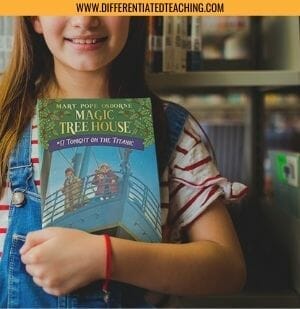
Like the rest of the Magic Tree House series, Tonight on the Titanic follows the story of Jack and Annie, who have traveled back in time in the magical treehouse they discovered in the woods behind their house. Throughout the story, the pair uses a book they brought with them to try to help the endangered passengers of the ill-fated voyage.
After helping two children traveling to New York to meet their parents, Jack and Annie attempt to relocate the treehouse before the ship sinks, but can they make it in time?
Cross-curricular connections: Social Studies – history, economics
Ideal for: 2nd-4th graders
Teach with Magic Tree House #17: Tonight on the Titanic & Fact Tracker: Titanic
- Buy the books: Magic Tree House #17: Tonight on the Titanic; Magic Tree House Fact Tracker: Titanic
- Get the audiobook: Magic Tree House #17: Tonight on the Titanic on Audible
- Lesson Materials: Magic Tree House #17: Tonight on the Titanic Novel Unit (coming soon); Magic Tree House Fact Tracker: Titanic Nonfiction Unit
15. Number the Stars
Number the Stars, by award-winning author Lois Lowry, is another great piece of literature to help students begin to understand the immense impact of World War II and the Holocaust for those who lived through it. Unlike Elly (mentioned above), this fictional story follows two ten year old girls living in Nazi occupied Denmark.
As the Nazi occupation continues, their lives take dramatic changes and when the Gestapo comes knocking on the door the pair realize that this is now a life-or-death situation. Ellen, one of the two girls, takes on the identity of her friend’s deceased sister in order to avoid being taken by the Nazis, but it isn’t long before even that isn’t enough to keep them safe.
After leaving for the countryside, the pair continues to face challenges that threaten Ellen’s life. It isn’t long before they also discover that Annemarie’s family is a part of the resistance. This changes everything…and leaves readers to wonder whether the girls will make it out of Denmark alive.
Cross-curricular connections: History – WWII, the Holocaust
Ideal for: 4th-6th graders
Teach with Number the Stars
- Buy the book: Number the Stars
- Get the audiobook: Number the Stars on FREE FreeTime Unlimited
- Lesson Materials: Number the Stars Novel Unit
16. James and the Giant Peach
Spring marks the beginning of fruit season in many parts of the country, so what better way to celebrate than by reading Roald Dahl’s classic, James and the Giant Peach?
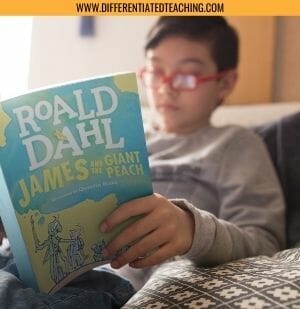
The story includes a young orphan named James who has been sent to live with his horrid and neglectful aunts after his parents die. Despite his mistreatment, James continues to work hard and one day he meets a man who offers him a magical opportunity. Unfortunately, things go awry when James takes a tumble near the peach tree in his aunt’s yard.
The next day something spectacular happens that will change James’ life forever.
Cross-curricular connections: Science – plants
Ideal for: 3rd-5th graders
Teach with James and the Giant Peach
- Buy the book: James and the Giant Peach
- Get the audiobook: James and the Giant Peach on Audible
- Lesson Materials: James and the Giant Peach Novel Unit
17. I Survived the Sinking of the Titanic, 1912
Looking to teach history as part of your spring novel study?
Another great option about the Titanic is this book from the I Survived series. These stories are especially engaging for learners because they’re told from the perspective of a kid just like them. As a result the historical relevance of the experience is magnified.
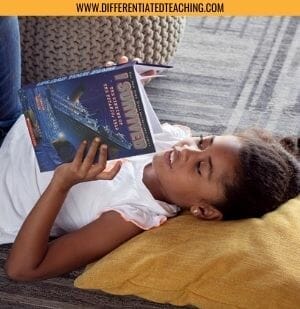
In I Survived the Sinking of the Titanic, a mischievous, well-do-to boy named George sails with his sister and aunt on the Titanic. When the ship hits an iceberg, George must face the challenge head-on in order to help his family survive.
Lauren Tarshis, the author, is a master of seamlessly blending fact and fiction. Her story creates an action-packed adventure that will leave your readers on the edge of their seats.
Cross-curricular connections: Social Studies – history, economics
Ideal for: 3rd-5th graders
Teach with I Survived the Sinking of the TItanic, 1912
- Buy the book: I Survived the Sinking of the TItanic, 1912
- Get the audiobook: I Survived the Sinking of the TItanic, 1912 on Epic
- Lesson Materials: I Survived the Sinking of the TItanic, 1912 Novel Unit (coming soon)
18. Night of the Twisters
Spring is also a time when conversations about weather awareness take center stage. Night of the Twisters offers a literary opportunity to talk about how best to prepare for incliminate weather. Written by Ivy Ruckman, the story is based on a real event that took place in Nebraska in 1980.
The main character is a 12-year old boy named Danny Hatch. After an evening of fun at the local swimming hole, Danny and his friend find themselves riding their bikes home as the weather begins to turn south. By the time the pair finish dinner, severe weather warnings have been issued for their area. When Danny’s mom leaves for a quick visit to check on their elderly neighbor, the boys find themselves in charge of Danny’s little brother Ryan just as the tornado sirens begin to blare.
After the storms pass, the trio discovers that the house has been reduced to a pile of rubble, and they set out to find Danny’s mom and wind up helping save others in their neighborhood as the winds continue to rage around them. Just when they think they’re finally headed to safety, another tornado touches down.
As the story continues, the reader is left to wonder – Will there be anything left by the time the storms end?
Cross-curricular connections: Science – weather
Ideal for: 4th-6th graders
Teach with Night of the Twisters
- Buy the book: Night of the Twisters
- Get the audiobook: Night of the Twisters on Audible
- Lesson Materials: Night of the Twisters Novel Unit
19. In the Year of the Boar & Jackie Robinson
This story follows a young girl named Shirley Temple Wong as she acclimates to her new life in United States after leaving China following the end of World War II. Desperate to fit in, Shirley tries to adopt American hobbies and mannerisms, but her efforts are often met with failure.
While many of her classmates aren’t open to embracing Shirley’s attempts, she finally makes a friend and begins to find her way within her new country. Thankfully, this doesn’t mean abandoning her roots, and Shirley is able to fit in without turning her back on her Chinese heritage.
When Shirley is lucky enough to meet her American hero – baseball player Jackie Robinson – it becomes clear that there are many similarities between the two and their attempts to fit in.
Overall, a great book with a fun sports theme woven throughout that will capture even hard to please the reader’s attention.
Cross-curricular connections: Social Studies – history & culture
Ideal for: 3rd-5th graders
Teach with In the Year of the Boar and Jackie Robinson
- Buy the book: In the Year of the Boar and Jackie Robinson
- Get the audiobook: In the Year of the Boar and Jackie Robinson on Audible
- Lesson Materials: In the Year of the Boar and Jackie Robinson Novel Unit
20. The Wonderful Wizard of Oz
Most students are well-aware of the movie, many aren’t aware that the story is based on a book that was published in 1900. This modern fairy tale is great for spring and offers a great opportunity to introduce them to the original.
Much like the movie, this story follows Dorothy as she is transported to a mysterious land following a tornado at her family farm in Kansas. Along the way, she meets a cast of characters all seeking the help of a powerful wizard. Despite the dangers posed by the Wicked Witch of the West, Dorothy and her companions are determined to see their wishes come true. Before that can happen, Dorothy must defeat the witch. Although many have tried in the past, Dorothy is determined to succeed…and does!
However, not all is as it seems in Oz, and Dorothy and her companions realize that their challenges may not be quite what they seem. Will Dorothy ever get home to Kansas?
Cross-curricular connections: Science – weather; Social-Emotional Learning
Ideal for: 4th-6th graders
Teach with The Wonderful Wizard of Oz
- Buy the book: The Wonderful Wizard of Oz
- Get the audiobook: The Wonderful Wizard of Oz on Audible
- Lesson Materials: The Wonderful Wizard of Oz Novel Unit
Spring Novels: Reading Essentials for Kids
Spring is a great time to introduce learners to a new novel, and it’s also the perfect time to start a novel study!
This list of my favorite spring chapter books can help you find exactly what you need for your classroom so that your students can begin to apply their comprehension skills to authentic literature experiences.
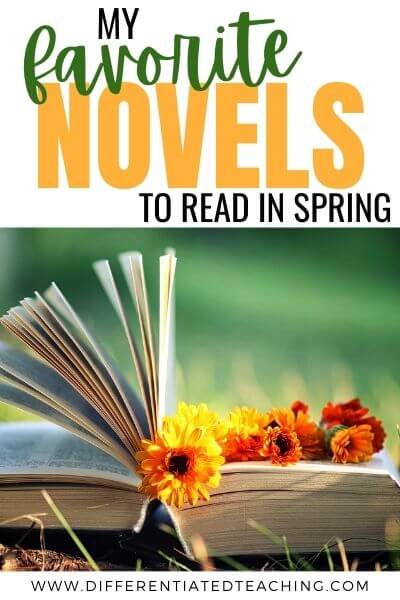
Now that you’ve seen my favorites, which books do you love to read in spring? Share your must-read spring novels and chapter books in the comments.





